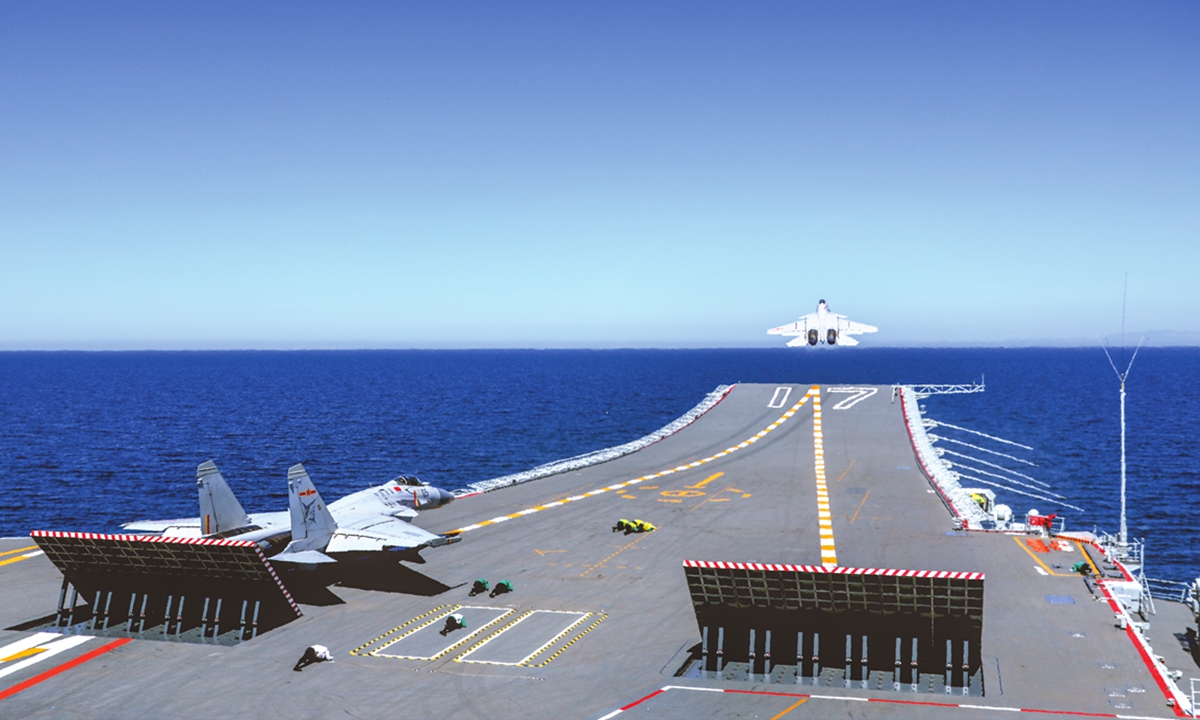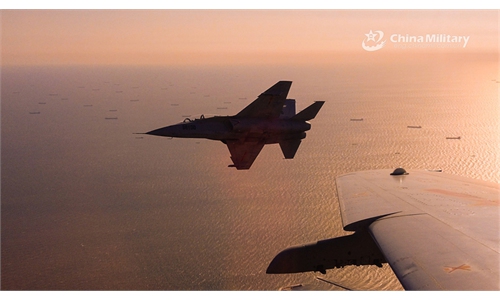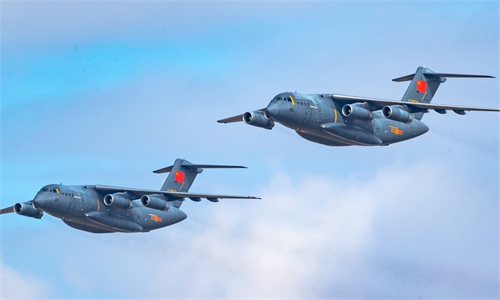Aircraft carrier Shandong spotted launching far seas drill amid China-Russia joint maritime patrol

J-15 fighter jets commence takeoffs from the aircraft carrier Shandong. Photo: Courtesy of Ding Zheng
China's Shandong aircraft carrier group reportedly started its first far seas exercise of the year after it was spotted on Tuesday operating in the West Pacific, where another group of Chinese and Russian warships are conducting a joint maritime patrol.
Amid Taiwan Straits and South China Sea tensions, as well as the US-led RIMPAC 2024 exercise that blatantly targets China, Chinese naval activities, not aimed at any other country, serve to enhance combat capabilities and deter unstable security factors, experts said on Wednesday.
The Chinese People's Liberation Army (PLA) Navy's aircraft carrier Shandong, the Type 055 large destroyer Yan'an, the Type 052D destroyer Guilin and the Type 054A Yuncheng were spotted sailing in the Philippine Sea on Tuesday, the news website of the US Naval Institute reported on the day, citing a news release from Japan's Ministry of Defense Joint Staff.
The Japanese news release said that the Shandong was observed conducting flight operations with its fighter aircraft and helicopters.
The Chinese aircraft carrier group was spotted sailing in the South China Sea near the Philippines in June, and analysts said that the carrier likely sailed from the South China Sea via the Bashi Channel to the south of the island of Taiwan into the Philippine Sea in the West Pacific.
A release by the defense authority on the island of Taiwan said that it spotted 37 PLA aircraft of various types around the island conducting air-sea joint training along with the carrier Shandong and other PLA Navy vessels on Wednesday.
It marks the first time the Shandong has embarked on a far seas exercise beyond the first island chain this year, observers noted, further mentioning that they are looking forward to seeing if the carrier will make new breakthroughs in terms of training intensity, new tactics practiced and new locations reached.
The aircraft carrier Shandong and its escorts are not the only PLA Navy warships currently operating in the West Pacific.
Citing the Russian Pacific Fleet, Russian News Agency Tass reported on July 4 that the Russian corvette Sovershenny joined the PLA Navy's Type 052D destroyer Yinchuan, Type 054A frigate Hengshui and Type 903 replenishment ship Weishanhu at a designated meeting point to commence the fourth joint Russia-China maritime patrol in the Asia-Pacific region since 2021 to bolster naval cooperation and maintain peace and stability.
The joint group is set to conduct anti-submarine and air defense drills and practice search and rescue measures at sea during their joint patrol, Tass reported.
The China-Russia joint group was spotted entering the West Pacific from the East China Sea via the Osumi Strait from July 4 to 5, according to Japan's Ministry of Defense Joint Staff.
Additional PLA Navy warships, including the Type 055 large destroyer Lhasa, the Type 903A replenishment ship Kekexilihu, the Type 052D destroyer Kaifeng and Type 054A frigate Yantai, also entered the West Pacific by July 1. They first entered the Sea of Japan from the East China Sea via the Tsushima Strait, then entered the West Pacific via the Tsugaru Strait, two separate news releases by Japan's Ministry of Defense Joint Staff said.
China has yet to officially announce these naval activities. Observers wonder if there is a link between the aircraft carrier Shandong's far seas exercise and the China-Russia joint patrol, reflecting on possible training objectives, and where the warships would travel to, considering the ongoing security tensions over the Taiwan question and the South China Sea issue, and that the Chinese and Russian naval activities are coinciding with the US-led RIMPAC exercise being held around Hawaii Islands, with China believed to be set as an imaginary enemy.
Zhang Junshe, a Chinese military expert, told the Global Times on Wednesday that the China-Russia joint maritime patrol has become regular occurrence, and such activities can further consolidate the strategic mutual trust between the two countries and the two militaries.
It is not impossible that the Shandong carrier group and the China-Russia joint group join force in the West Pacific waters to conduct mock confrontation drills or joint defense drills, Zhang said.
In addition to traditional areas such as the East China Sea, the West Pacific and the North Pacific, it cannot be ruled out that the groups could sail to regions farther away, such as the East Pacific and South Pacific, which completely conforms to the international law and practices, Zhang said.
The Chinese drills combined with the China-Russia joint patrol are completely different from the US-led RIMPAC exercise, as they are not targeted at any other country. The RIMPAC, on the other hand, is obviously simulating a scenario in which the US militarily interferes in the Taiwan question in case of a conflict, analysts said.
Another Chinese military expert, who requested anonymity, told the Global Times on Wednesday that while the PLA Navy's exercises and drills are prescheduled and are not related with the ongoing situations, they contribute to regional peace and stability by deterring unstable factors and provide strategic power balancing.
The goal of any exercise should be enhancing combat capabilities and safeguarding national sovereignty, territorial integrity, security and development interests, the expert said.




